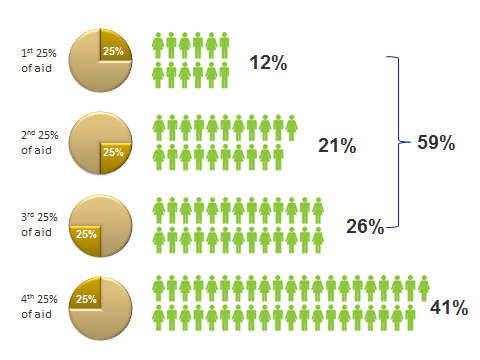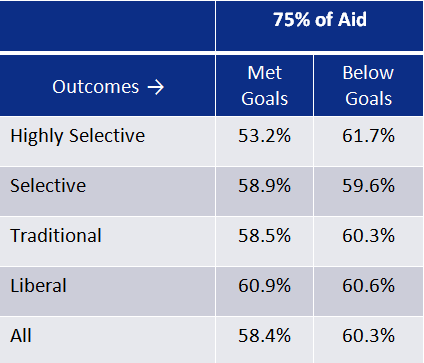enrollment
Calculating the most efficient and effective use of financial aid
Question: What percentage of your incoming first-year students receive 75 percent of your institutional aid resources?
This blog is the second of a three part series. In the first installment I looked at price sensitivity in relation to the wealth of private colleges. While there may be concepts here that help inform the awarding of aid at public institutions, the simple fact that public institutions usually have a much smaller pool of institutional aid makes this topic less relevant to them. (One quick take-away for all institutions should be that full- or near-full-ride scholarships are perhaps much less effective than having those funds spread out more broadly.)
Calculating your distribution of aid number
To calculate your distribution of aid number (which I’ll refer to as the “number”) for your campus, simply create a list of your students with the amount of institutional aid awarded to each, ordered from high to low (and including students getting no institutional aid). Determine how much aid makes up 75 percent of your total aid, and then calculate what percentage of students it takes to use up that much aid.
While every institution will have a different “ideal” distribution of aid, consider these examples of awarding ratios. If 50 percent of your students are receiving 75 percent of your institutional aid, that means that the other 50 percent of your students are receiving the remaining 25 percent of your aid. In this case, there may be ways to use your aid more effectively because there may be large numbers of non-enrolled students who are not being reached by your current aid program. Likewise, if 70 percent of your students are receiving 75 percent of your aid, your aid program may not be discriminating enough and there may well be groups of students who are not being reached.
The following is an example from an actual campus.

Notice that 12 percent of the students received the first 25 percent of aid; 21 percent of students received the next 25 percent; 26 percent the third 25 percent of aid; and the last 41 percent of students received the final 25 percent of aid. Therefore, 59 percent of students received 75 percent of this institution’s aid. Note that this campus exceeded its enrollment goals by 28 percent, had a yield of 50 percent, and a first-to-second-year retention rate of 81 percent.
The importance of systematic, annual tracking
For one campus, a 59 percent figure may be an appropriate distribution of aid number, but this number cannot be assumed to be appropriate for every campus, or even the ideal number for this campus each year. Each campus serves a unique population, and as enrollment goals change, so does the ideal allocation of aid. In the example above, 89 percent of this institution’s students filed a FAFSA and 54 percent of those were PELL eligible. Campuses which serve a needier population will probably have larger FAFSA and PELL numbers in these two areas, while campuses that are more selective and whose families are wealthier will probably have lower numbers. The important activity is to track your metrics from year to year so that you understand how student need changes.
Let metrics inform your aid policy changes
When new aid programs are being proposed, it is important to understand if they will make your number go up or down. Often a department on campus wants to offer a new scholarship to recruit a specific type of student. The reasons for wanting to start the program are in most cases valid, but many times do not take a broader view of your current aid program and do not necessarily impact your ability to recruit more (or better) students. If your campus has a number which is closer to 50 percent than 70 percent, you may want to scrutinize a new program proposal which directs a lot of dollars to few students. On the other hand, if your campus has a number closer to 70 percent (indicating you spread your dollars more broadly), you may well benefit from targeting aid more specifically.
Among the 150 private colleges and universities that use Noel-Levitz financial aid consulting services, campuses that distribute aid more broadly (and therefore have a higher number) are more likely to meet their enrollment goals. However, this varies by selectivity. Schools that are the most selective (measured by average SAT/ACT test scores) tend to have the greatest variance when comparing the number for those that met their enrollment goals against those that did not. Colleges with liberal enrollments actually have statistically equal numbers.

Here’s another way to understand this point. Selective institutions have higher sticker prices, and while they attract a much wealthier clientele (as outlined in my first blog entry on this set of topics), the difference between the sticker price and the true cost becomes less manageable if aid is not distributed more broadly. For institutions with liberal admissions policies, whose populations in general are much more needy, institutional aid usually complements federal and state aid. As a result, aid is distributed more broadly over the entire population on the basis of financial need.
In the last installment of this series, I will explore how the wealth indicators from my first blog along with the efficient distribution aid discussed here relate to other outcome measures such as yield and discount rates. If you’re curious about what your ideal distribution of aid number is, please e-mail me. I’m always happy to share my insights and, if you don’t mind sharing some data with me, I can help you understand how to find a number that balances student need with your own revenue needs.